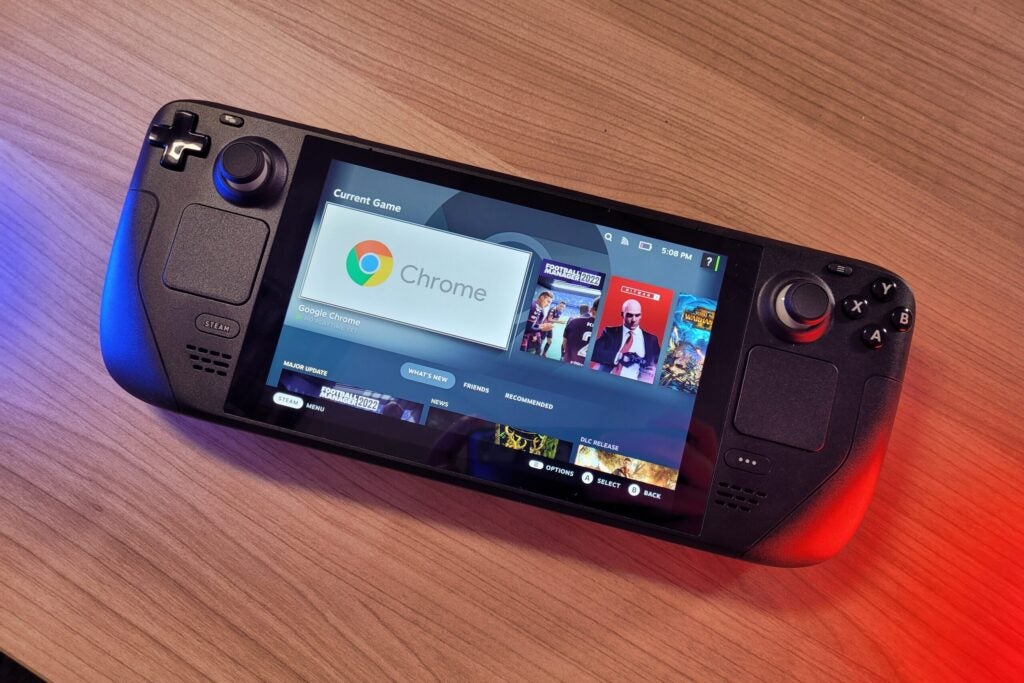We’ve just gotten more details on the ROG Ally, courtesy of Asus and AMD, namely details of the Ryzen Z1 series chips it’ll feature. Let’s dive into what this means for how it’ll compare with the Steam Deck.
The Asus ROG Ally seems like it could be the first serious competitor to Valve’s gaming handheld. But, it’s looking so good that price is surely going to be an issue.
Now we know more details on its key internals, forged by AMD, we can look deeper at how these specs stack up with the competition. You’ll have to wait for price and release date for the ROG Ally though, that’s coming on May 11. For now, read on for what you need to know on Asus handheld versus the Steam Deck.
The Asus ROG Ally is more powerful
According to YouTuber Dave2D, Asus claims that the new ROG Ally portable is 2x more powerful than the Steam Deck.
While we can’t verify that claim until testing, it’s not a huge surprise given the components powering the portable. The Asus ROG Ally packs a custom AMD Ryzen Z1 series chip, that’ll come in two flavours: Ryzen Z1 and Ryzen Z1 Extreme. Both will be 4nm, with a Zen 4 CPU and RDNA 3 GPU.
We don’t know the clock speeds of the new chip just yet, but early Geekbench tests (via Videocardz) touts that the Z1 will run up to 5.0GHz and the Z1 Extreme going up to 5.1GHz. The Steam Deck comes in as up to 3.5GHz. Further, the Z1 will feature 4 graphical compute units and the Z1 Extreme is set to come with 12, that’s compared with 8 on the Steam Deck.
Comparing the architectures, the Steam Deck is using a Zen 2 CPU and RDNA 2 GPU, which means it’s a little behind in terms of component generations.
We don’t know for sure what kind of performance these specs are capable of for the ROG Ally, but we’re expecting it to allow games to run at higher graphics settings than the Steam Deck devices. To get a smooth performance for modern games such as Elden Ring on Steam Deck, you generally have to lower the resolution or the graphics settings.
Despite the extra performance, Dave2D claims that the Asus ROG Ally actually runs quieter than the Steam Deck, with the latter becoming noticeably noisy when under stress.

The ROG Ally has a 120Hz refresh rate
Both the Steam Deck and Asus ROG Ally have the same 7-inch screen size, but differ greatly when it comes to the specs of the display.
Most notably, the Asus ROG Ally’s refresh rate tops out at an impressive 120Hz. This should take advantage of the portable’s firepower, with games running at high refresh rates appearing smoother than they would on the 60Hz panel of the Steam Deck.
The ROG Ally also boasts a better screen resolution, coming in at 1920×1080, compared to the slightly less pixel-packed 1280×800 panel. Asus has also opted for a 16:9 aspect ratio, which is a little more rectangular than the Steam Deck’s 16:10 counterpart.
And to round it all off, the Asus ROG Ally has a brighter screen, capable of climbing up to 500 nits, whereas the Steam Deck is limited to 400 nits.
Fifa 23 with DualSense Controller Bundle
The perfect bundle for any football fans out there as it nabs you an extra DualSense controller to enjoy some multiplayer fun.
- Argos
- Lowest Price Yet
- Now £69.99
Steam Deck runs on SteamOS 3.0
The Steam Deck is unique to other gaming portables, as it uses SteamOS. This is an operating system created by Valve, and so is locked down to the Steam library and store. Since the Steam Deck runs on Linux, you are able to open a desktop mode to use handheld like a portable PC, but it’s not very user friendly for those more accustomed to Windows.
Speaking of which, the Asus ROG Ally runs on Windows 11, allowing for more flexibility in terms of software. You’ll be able to use a browser just like a standard laptop or desktop or even load up apps such as Game Pass and GeForce Experience.
Asus has also created a custom version of its Armoury Crate app which should load up by default, allowing you to boot up games and alter settings easily. Although it may not be quite as slick as SteamOS or the Nintendo Switch interface. We’ll have to wait for testing to find out.

The Steam Deck has touchpads
The Asus ROG Ally has a largely similar control setup as the Steam Deck. Both feature dual analogue sticks, a D-pad, shoulder buttons and triggers, front-facing buttons and even back buttons – although the Steam Deck has an extra pair of the latter.
Not much separates the two in terms of inputs then, but those who like trackpads may be sad to see them omitted on the ROG Ally. The Steam Deck’s trackpads aren’t quite precise enough to replace a gaming mouse for controlling first-person shooters and the like, but we still found them fairly useful for menu navigation in the likes of Football Manager.
There isn’t a big difference for ports either, both sporting a microSD card slot for storage expansion and a headphone jack. The ROG Ally boasts a slight advantage with a fingerprint sensor though, which could come in handy for logging into Windows.
The ROG Ally also has a connection port for Asus’ XG mobile GPU, which is an external graphics solution that can boost the performance even further. This doesn’t come with the Ally, and is a very expensive accessory, but is still nice to have the option.
Asus ROG Ally will probably be more expensive
Asus hasn’t announced the price of the ROG Ally just yet, that’s coming on May 11 at the full launch event, so we don’t really have an idea of how much it will cost. However, we expect the ROG Ally to be significantly more expensive than the Steam Deck due to specs.
With Asus claiming its portable is 2x more powerful than the Steam Deck, as well as having a screen with a higher refresh rate, it’s going to cost a lot more to manufacture.
We really wouldn’t be surprised if Asus’ portable approaches the $1000/£1000 mark, which will likely make it too expensive for the vast majority of gamers. But let’s hope we’re wrong, as it would be great to see a price that challenges the affordability of the $399/£349 Steam Deck.
